Page 35 of 558
•For vehicles not equipped with the EVIC, perform the
following procedure:
1. Close all doors and place the key in the ignition.
2. Cycle the ignition switch between OFF and ON/RUN
and then back to OFF five times, ending up in the
ON/RUN position.
3. Press the power door UNLOCK switch to unlock the
doors.
4. A single chime will indicate the completion of the
programming. Repeat these steps if you want to return this feature to its
previous setting.
NOTE:
Use the Automatic Unlock Doors On Exit feature
in accordance with local laws.
Child-Protection Door Lock System — Rear
Doors
To provide a safer environment for small children riding
in the rear seats, the rear doors are equipped with a
Child-Protection Door Lock system.
2
THINGS TO KNOW BEFORE STARTING YOUR VEHICLE 33
Page 36 of 558
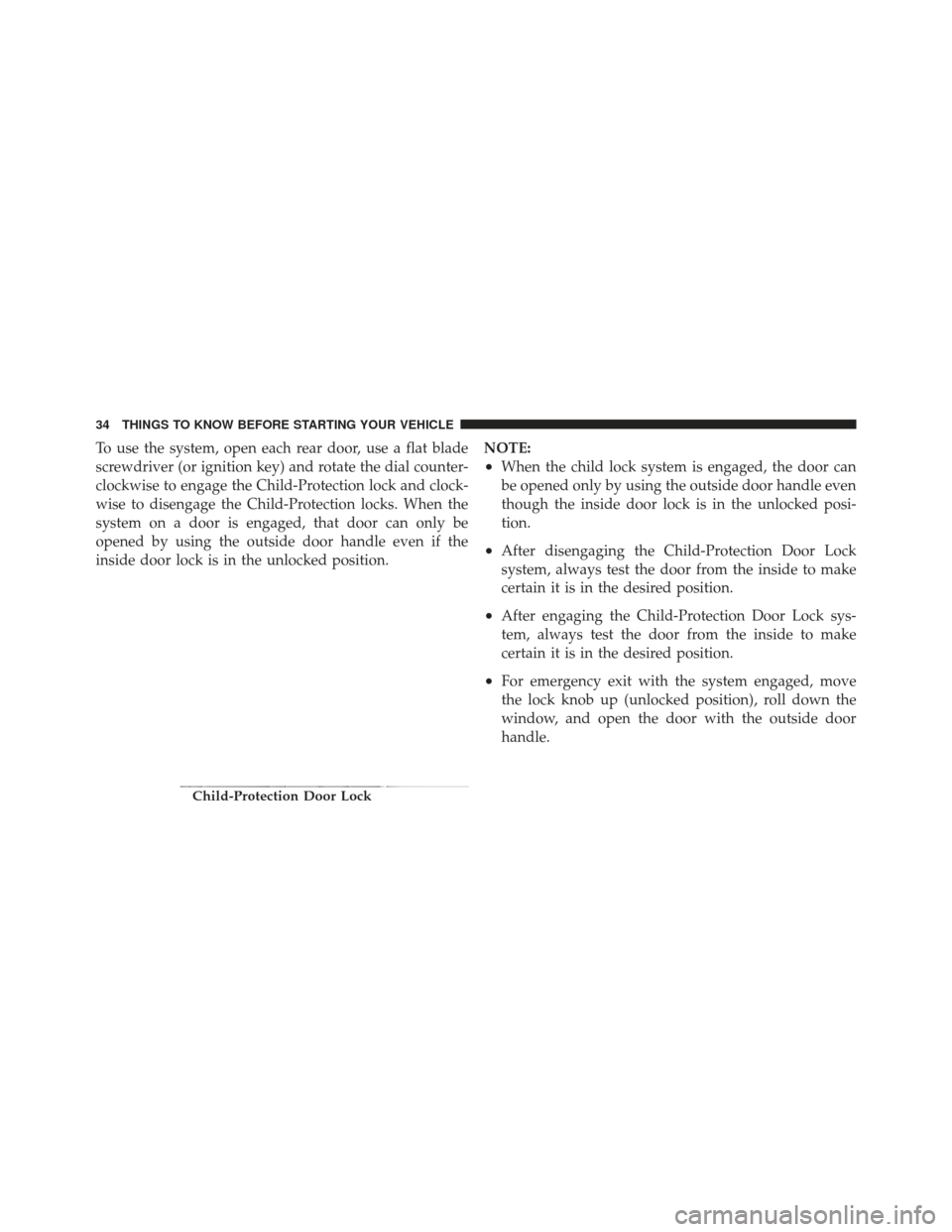
To use the system, open each rear door, use a flat blade
screwdriver (or ignition key) and rotate the dial counter-
clockwise to engage the Child-Protection lock and clock-
wise to disengage the Child-Protection locks. When the
system on a door is engaged, that door can only be
opened by using the outside door handle even if the
inside door lock is in the unlocked position.NOTE:
•When the child lock system is engaged, the door can
be opened only by using the outside door handle even
though the inside door lock is in the unlocked posi-
tion.
•After disengaging the Child-Protection Door Lock
system, always test the door from the inside to make
certain it is in the desired position.
•After engaging the Child-Protection Door Lock sys-
tem, always test the door from the inside to make
certain it is in the desired position.
•For emergency exit with the system engaged, move
the lock knob up (unlocked position), roll down the
window, and open the door with the outside door
handle.
Child-Protection Door Lock
34 THINGS TO KNOW BEFORE STARTING YOUR VEHICLE
Page 38 of 558
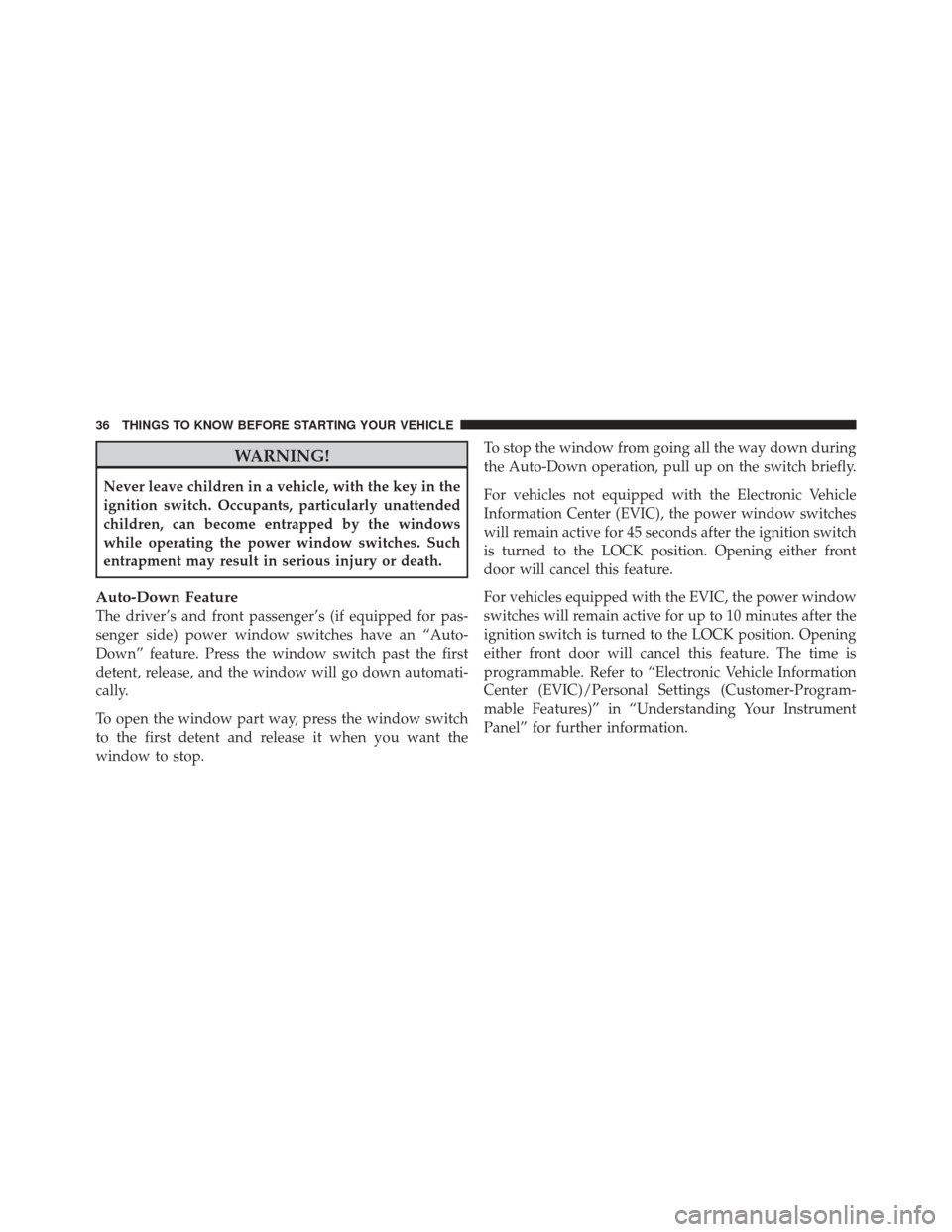
WARNING!
Never leave children in a vehicle, with the key in the
ignition switch. Occupants, particularly unattended
children, can become entrapped by the windows
while operating the power window switches. Such
entrapment may result in serious injury or death.
Auto-Down Feature
The driver’s and front passenger’s (if equipped for pas-
senger side) power window switches have an “Auto-
Down” feature. Press the window switch past the first
detent, release, and the window will go down automati-
cally.
To open the window part way, press the window switch
to the first detent and release it when you want the
window to stop.To stop the window from going all the way down during
the Auto-Down operation, pull up on the switch briefly.
For vehicles not equipped with the Electronic Vehicle
Information Center (EVIC), the power window switches
will remain active for 45 seconds after the ignition switch
is turned to the LOCK position. Opening either front
door will cancel this feature.
For vehicles equipped with the EVIC, the power window
switches will remain active for up to 10 minutes after the
ignition switch is turned to the LOCK position. Opening
either front door will cancel this feature. The time is
programmable. Refer to “Electronic Vehicle Information
Center (EVIC)/Personal Settings (Customer-Program-
mable Features)” in “Understanding Your Instrument
Panel” for further information.
36 THINGS TO KNOW BEFORE STARTING YOUR VEHICLE
Page 42 of 558
LIFTGATE
To open the liftgate, pull up (squeeze) on the handle and
lift.NOTE:
Use the power door LOCK switch on either front
door trim panel or the Remote Keyless Entry (RKE)
transmitter to lock and unlock the liftgate. The manual
door locks on the doors and the driver’s door lock
cylinder will not lock and unlock the liftgate.
WARNING!
Driving with the liftgate open can allow poisonous
exhaust gases into your vehicle. You and your pas-
sengers could be injured by these fumes. Keep the
liftgate closed when you are operating the vehicle.
Liftgate Flipper Glass
The liftgate flipper glass is also unlocked when the
liftgate is unlocked. To open the flipper glass, push up on
the window switch located on the liftgate.
Liftgate Release
40 THINGS TO KNOW BEFORE STARTING YOUR VEHICLE
Page 68 of 558
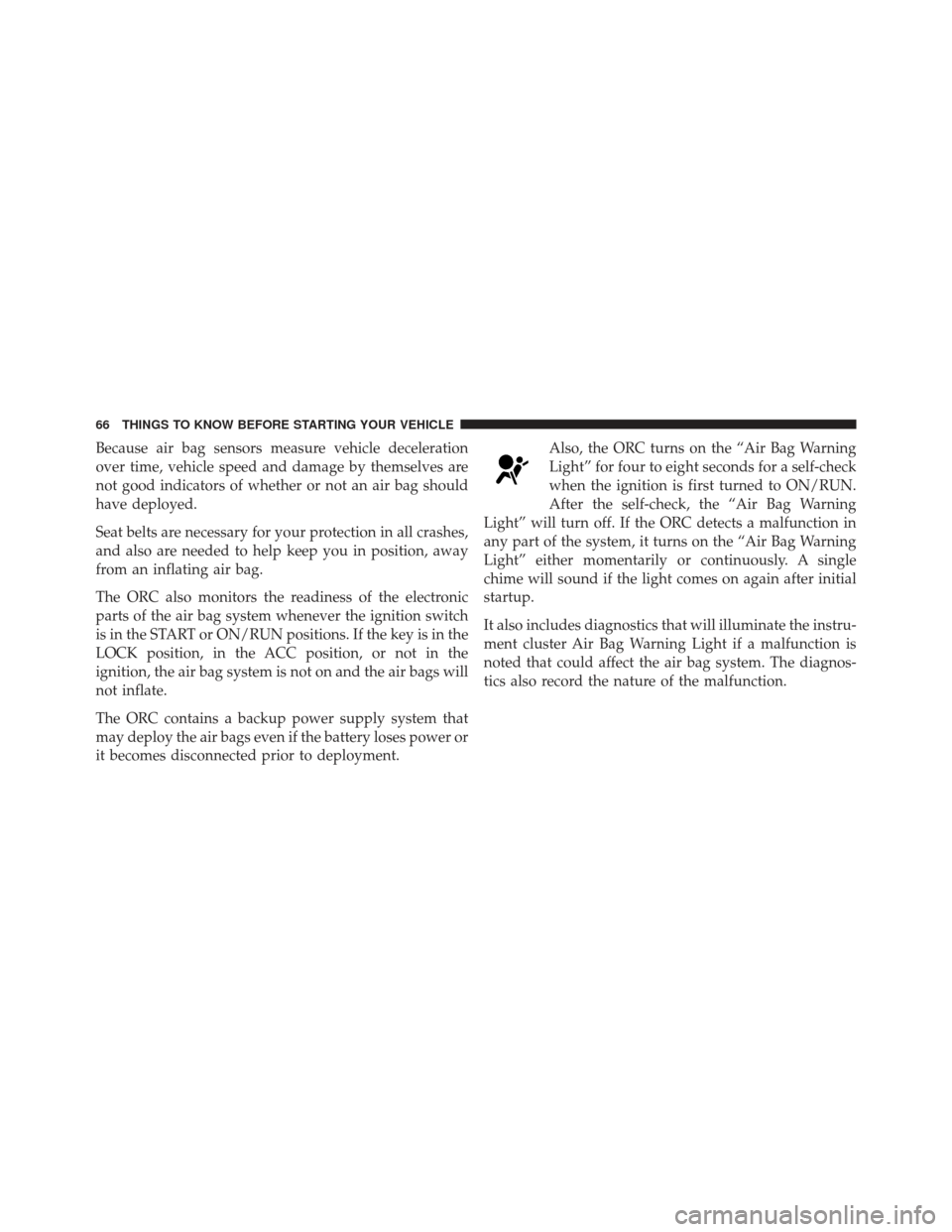
Because air bag sensors measure vehicle deceleration
over time, vehicle speed and damage by themselves are
not good indicators of whether or not an air bag should
have deployed.
Seat belts are necessary for your protection in all crashes,
and also are needed to help keep you in position, away
from an inflating air bag.
The ORC also monitors the readiness of the electronic
parts of the air bag system whenever the ignition switch
is in the START or ON/RUN positions. If the key is in the
LOCK position, in the ACC position, or not in the
ignition, the air bag system is not on and the air bags will
not inflate.
The ORC contains a backup power supply system that
may deploy the air bags even if the battery loses power or
it becomes disconnected prior to deployment.Also, the ORC turns on the “Air Bag Warning
Light” for four to eight seconds for a self-check
when the ignition is first turned to ON/RUN.
After the self-check, the “Air Bag Warning
Light” will turn off. If the ORC detects a malfunction in
any part of the system, it turns on the “Air Bag Warning
Light” either momentarily or continuously. A single
chime will sound if the light comes on again after initial
startup.
It also includes diagnostics that will illuminate the instru-
ment cluster Air Bag Warning Light if a malfunction is
noted that could affect the air bag system. The diagnos-
tics also record the nature of the malfunction.
66 THINGS TO KNOW BEFORE STARTING YOUR VEHICLE
Page 75 of 558
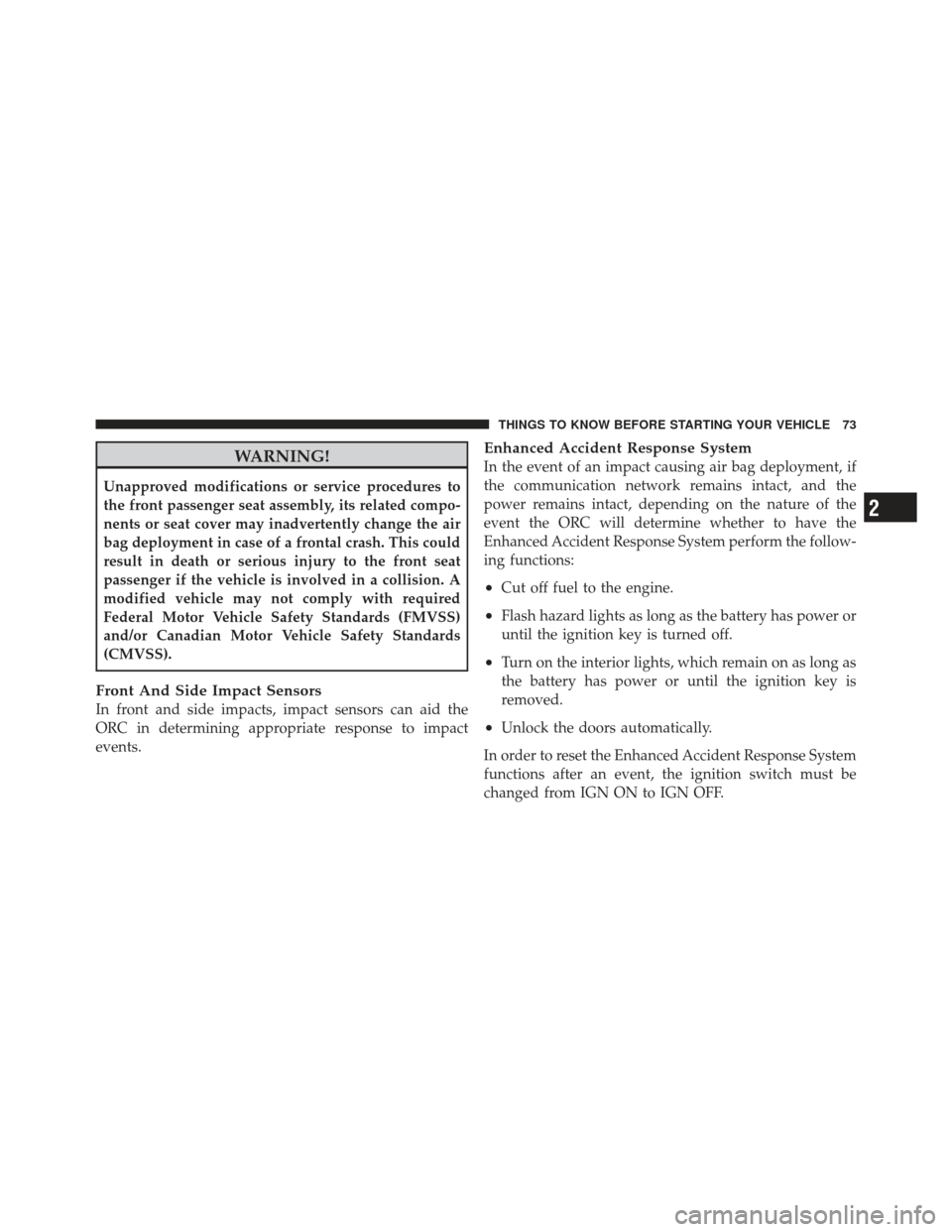
WARNING!
Unapproved modifications or service procedures to
the front passenger seat assembly, its related compo-
nents or seat cover may inadvertently change the air
bag deployment in case of a frontal crash. This could
result in death or serious injury to the front seat
passenger if the vehicle is involved in a collision. A
modified vehicle may not comply with required
Federal Motor Vehicle Safety Standards (FMVSS)
and/or Canadian Motor Vehicle Safety Standards
(CMVSS).
Front And Side Impact Sensors
In front and side impacts, impact sensors can aid the
ORC in determining appropriate response to impact
events.
Enhanced Accident Response System
In the event of an impact causing air bag deployment, if
the communication network remains intact, and the
power remains intact, depending on the nature of the
event the ORC will determine whether to have the
Enhanced Accident Response System perform the follow-
ing functions:
•Cut off fuel to the engine.
•Flash hazard lights as long as the battery has power or
until the ignition key is turned off.
•Turn on the interior lights, which remain on as long as
the battery has power or until the ignition key is
removed.
•Unlock the doors automatically.
In order to reset the Enhanced Accident Response System
functions after an event, the ignition switch must be
changed from IGN ON to IGN OFF.
2
THINGS TO KNOW BEFORE STARTING YOUR VEHICLE 73
Page 96 of 558
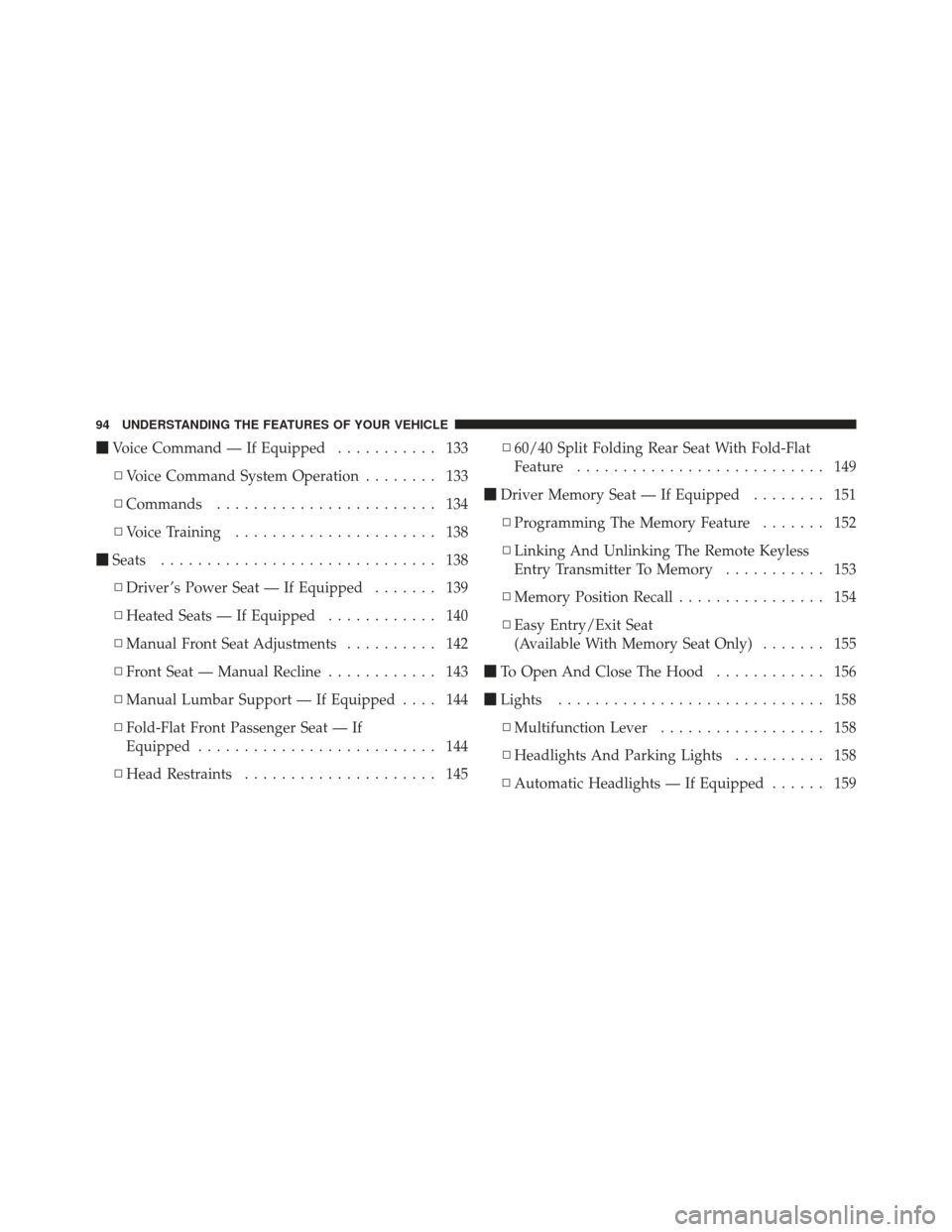
�Voice Command — If Equipped ........... 133
▫ Voice Command System Operation ........ 133
▫ Commands ........................ 134
▫ Voice Training ...................... 138
� Seats .............................. 138
▫ Driver ’s Power Seat — If Equipped ....... 139
▫ Heated Seats — If Equipped ............ 140
▫ Manual Front Seat Adjustments .......... 142
▫ Front Seat — Manual Recline ............ 143
▫ Manual Lumbar Support — If Equipped .... 144
▫ Fold-Flat Front Passenger Seat — If
Equipped .......................... 144
▫ Head Restraints ..................... 145 ▫
60/40 Split Folding Rear Seat With Fold-Flat
Feature ........................... 149
� Driver Memory Seat — If Equipped ........ 151
▫ Programming The Memory Feature ....... 152
▫ Linking And Unlinking The Remote Keyless
Entry Transmitter To Memory ........... 153
▫ Memory Position Recall ................ 154
▫ Easy Entry/Exit Seat
(Available With Memory Seat Only) ....... 155
� To Open And Close The Hood ............ 156
� Lights ............................. 158
▫ Multifunction Lever .................. 158
▫ Headlights And Parking Lights .......... 158
▫ Automatic Headlights — If Equipped ...... 159
94 UNDERSTANDING THE FEATURES OF YOUR VEHICLE
Page 104 of 558
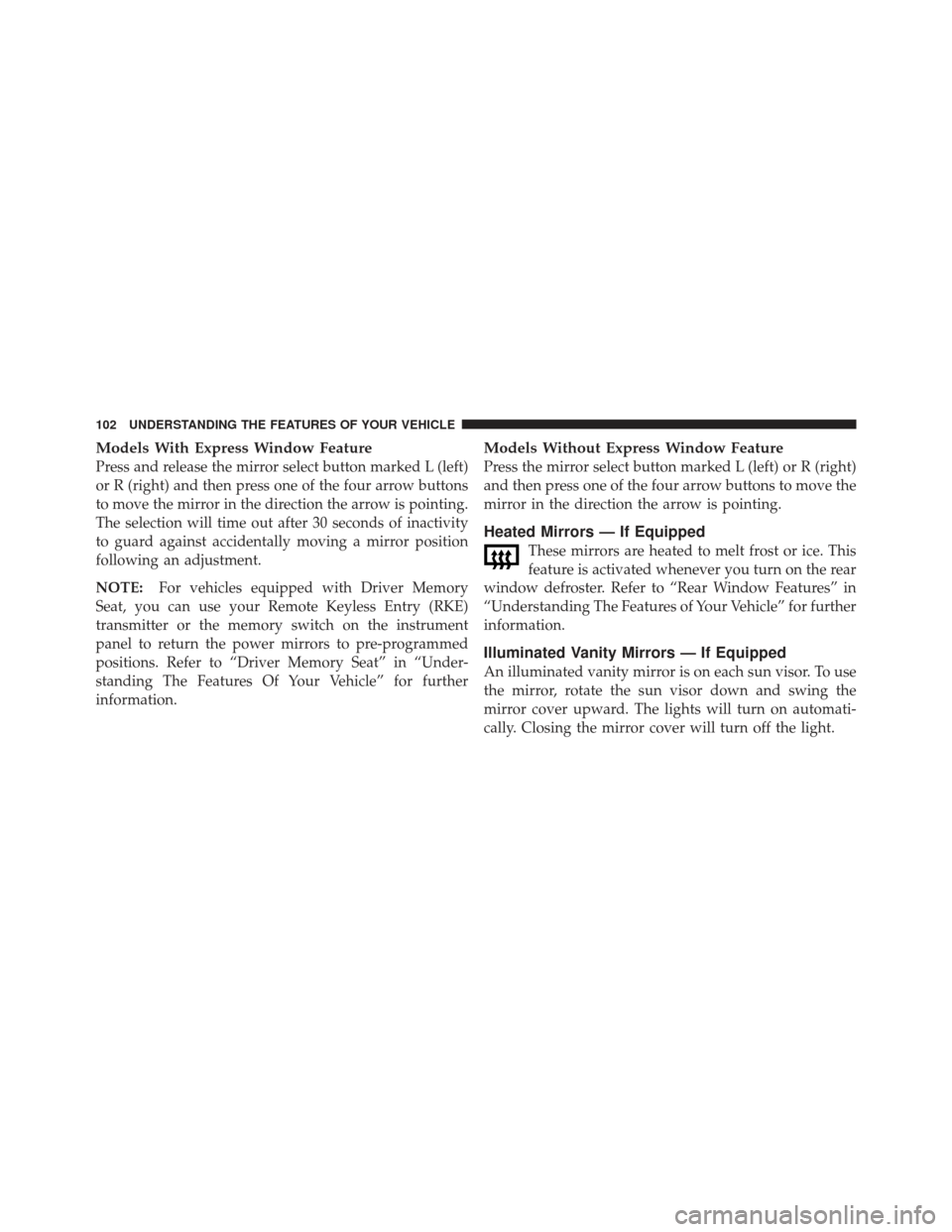
Models With Express Window Feature
Press and release the mirror select button marked L (left)
or R (right) and then press one of the four arrow buttons
to move the mirror in the direction the arrow is pointing.
The selection will time out after 30 seconds of inactivity
to guard against accidentally moving a mirror position
following an adjustment.
NOTE:For vehicles equipped with Driver Memory
Seat, you can use your Remote Keyless Entry (RKE)
transmitter or the memory switch on the instrument
panel to return the power mirrors to pre-programmed
positions. Refer to “Driver Memory Seat” in “Under-
standing The Features Of Your Vehicle” for further
information.
Models Without Express Window Feature
Press the mirror select button marked L (left) or R (right)
and then press one of the four arrow buttons to move the
mirror in the direction the arrow is pointing.
Heated Mirrors — If Equipped
These mirrors are heated to melt frost or ice. This
feature is activated whenever you turn on the rear
window defroster. Refer to “Rear Window Features” in
“Understanding The Features of Your Vehicle” for further
information.
Illuminated Vanity Mirrors — If Equipped
An illuminated vanity mirror is on each sun visor. To use
the mirror, rotate the sun visor down and swing the
mirror cover upward. The lights will turn on automati-
cally. Closing the mirror cover will turn off the light.
102 UNDERSTANDING THE FEATURES OF YOUR VEHICLE